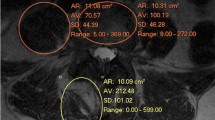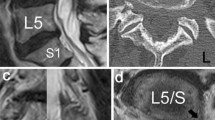Abstract
Purpose
Assessment of the integrity of the multifidus muscles and corresponding nerve roots, post-open (OSS) versus minimally invasive spinal surgery (MISS) for lumbar spine fractures.
Methods
We investigated the first six patients undergoing MISS in our institution and age- and sex-matched them with 6 random patients who previously had OSS. All had a similar lumbar fracture configuration without evidence of spinal cord injury. All were assessed using ultrasound muscle quantification and electromyographic studies at a minimum of 6 months post-operatively. Mean cross-sectional area (CSA) was measured at sequential levels within and adjacent to the operative field. Concentric needle electromyography was performed at instrumented and adjacent non-instrumented levels in each patient.
Results
Mean CSA across all lumbar multifidus muscles was 4.29 cm2 in the MISS group, 2.26 cm2 for OSS (p = 0.08). At the instrumented levels, mean CSA was 4.21 cm2 for MISS and 2.03 cm2 for OSS (p = 0.12). At non-instrumented adjacent levels, mean CSA was 4.46 cm2 in the MISS group, 2.87 cm2 for OSS (p = 0.05).
Electromyography at non-instrumented adjacent levels demonstrated nerve function within normal limits in 5/6 levels in the MISS group compared to 1/6 levels in the OSS (p = 0.03). Instrumented levels demonstrated nerve function within normal limits in 5/12 levels in the MISS group compared with 4/12 in the OSS group, including moderate–severe denervation at 5 levels in the OSS group (p = 0.15).
Conclusions
Posterior instrumented MISS demonstrates a significantly superior preservation of the medial branch of the posterior ramus of the spinal nerve and less muscle atrophy, particularly at adjacent levels when compared to OSS.



Similar content being viewed by others
References
MacDonald DA, Moseley GL, Hodges PW (2006) The lumbar multifidus: does the evidence support clinical beliefs? Man Ther 11(4):254–263
Macintosh J, Valencia F, Bogduk N et al (1986) The morphology of the human lumbar multifidus. Clin Biomech 1(4):196–204
Rantanen J, Hurme M, Falck B et al (1993) The lumbar multifidus muscle five years after surgery for a lumbar intervertebral disc herniation. Spine 18:568–574
Sihvonen T, Herno A, Paljiarvi L et al (1993) Local denervation atrophy of paraspinal muscles in postoperative failed back syndrome. Spine 18:575–581
Gejo R, Matsui H, Kawaguchi Y et al (1999) Serial changes in trunk muscle performance after posterior lumbar surgery. Spine 24:1023–1028
Weinstein JN, Rydevik BL, Rauschning W (1992) Anatomic and technical considerations of pedicle screw fixation. Clin Orthop Relat Res 284:34–46
Styf JR, Willen J (1998) The effects of external compression by three different retractors on pressure in the erector spine muscles during and after posterior lumbar spine surgery in humans. Spine 23:354–358
Nagayama R, Nakamura H, Yamano Y et al (2000) An experimental study of the effects of nerve root retraction on the posterior ramus. Spine (Phila Pa 1976) 25(4):418–424
Kim KT, Lee SH, Suk KS et al (2006) The quantitative analysis of tissue injury markers after mini-open lumbar fusion. Spine (Phila Pa 1976) 31(6):712–716
Rahman M, Summers LE, Richter B et al (2008) Comparison of techniques for decompressive lumbar laminectomy: the minimally invasive versus the “classic” open approach. Minim Invasive Neurosurg 51(2):100–105
McGirt MJ, Parker SL, Lerner J et al (2011) Comparative analysis of perioperative surgical site infection after minimally invasive versus open posterior/transforaminal lumbar interbody fusion: analysis of hospital billing and discharge data from 5170 patients. J Neurosurg Spine 14(6):771–778
Hides JA, Cooper DH, Stokes MJ (1992) Diagnostic ultrasound imaging for measurement of the lumbar multifidus muscle in normal young adults. Physiother Theory Pract 8(1):19–26
Haig AJ, Moffroid M, Henry S et al (1991) A technique for needle localization in paraspinal muscles with cadaveric confirmation. Muscle Nerve 14(6):521–526
Hides J, Gilmore C, Stanton W et al (2008) Multifidus size and symmetry among chronic LBP and healthy asymptomatic subjects. Man Ther 13(1):43–49
Payer M (2011) “Minimally invasive” lumbar spine surgery: a critical review. Acta Neurochir (Wien) 153(7):1455–1459
Foley KT, Lefkowitz MA (2002) Advances in minimally invasive spine surgery. Clin Neurosurg 49:499–517
Mobbs RJ, Sivabalan P, Li J (2011) Technique, challenges and indications for percutaneous pedicle screw fixation. J Clin Neurosci 18(6):741–749
Koppenhaver SL, Hebert JJ, Fritz JM et al (2009) Reliability of rehabilitative ultrasound imaging of the transversus abdominis and lumbar multifidus muscles. Arch Phys Med Rehabil 90(1):87–94
Hebert JJ, Koppenhaver SL, Parent EC et al (2009) A systematic review of the reliability of rehabilitative ultrasound imaging for the quantitative assessment of the abdominal and lumbar trunk muscles. Spine (Phila Pa 1976) 34(23):E848–E856
Wallwork TL, Hides JA, Stanton WR (2007) Intrarater and interrater reliability of assessment of lumbar multifidus muscle thickness using rehabilitative ultrasound imaging. J Orthop Sports Phys Ther 37(10):608–612
Haig AJ, LeBreck DB, Powley SG (1995) Paraspinal mapping. Quantified needle electromyography of the paraspinal muscles in persons without low back pain. Spine (Phila Pa 1976) 20(6):715–721
Haig AJ, Talley C, Grobler LJ et al (1993) Paraspinal mapping: quantified needle electromyography in lumbar radiculopathy. Muscle Nerve 16(5):477–484
Regev GJ, Lee YP, Taylor WR et al (2009) Nerve injury to the posterior rami medial branch during the insertion of pedicle screws: comparison of mini-open versus percutaneous pedicle screw insertion techniques. Spine (Phila Pa 1976) 34(11):1239–1242
Kim DY, Lee SH, Chung SK et al (2005) Comparison of multifidus muscle atrophy and trunk extension muscle strength: percutaneous versus open pedicle screw fixation. Spine (Phila Pa 1976) 30(1):123–129
Li C, Xu HZ, Wang XY et al (2007) Comparison of the paraspinal muscle change of percutaneous and open pedicle screw fixation in the treatment for thoracolumbar fractures. Zhonghua Wai Ke Za Zhi 45(14):972–975 (In Chinese)
Kawaguchi Y, Matsui H, Tsuji H (1996) Back muscle injury after posterior lumbar spine surgery. A histologic and enzymatic analysis. Spine (Phila Pa 1976) 21(8):941–944
Datta G, McGregor A, Medhi-Zadeh S et al (2010) The impact of intermittent retraction on paraspinal muscle function during lumbar surgery. Spine (Phila Pa 1976) 35(20):E1050–E1057
Mannion AF, Denzler R, Dvorak J et al (2007) A randomised controlled trial of post-operative rehabilitation after surgical decompression of the lumbar spine. Eur Spine J 16(8):1101–1117
Mannion AF, Müntener M, Taimela S et al (2001) Comparison of three active therapies for chronic low back pain: results of a randomized clinical trial with one-year follow-up. Rheumatology 40(7):772–778 (Oxford)
Sanderson PL, Fraser RD, Hall DJ et al (1999) Short segment fixation of thoracolumbar burst fractures without fusion. Eur Spine J 8(6):495–500
Dai LY, Jiang LS, Jiang SD (2009) Posterior short-segment fixation with or without fusion for thoracolumbar burst fractures. a five to seven-year prospective randomized study. J Bone Joint Surg Am 91(5):1033–1041
Hyun SJ, Kim YB, Kim YS et al (2007) Postoperative changes in paraspinal muscle volume: comparison between paramedian interfascial and midline approaches for lumbar fusion. J Korean Med Sci 22(4):646–651
Stevens KJ, Spenciner DB, Griffiths KL et al (2006) Comparison of minimally invasive and conventional open posterolateral lumbar fusion using magnetic resonance imaging and retraction pressure studies. J Spinal Disord Tech 19(2):77–86
Wood K, Buttermann G, Mehbod A et al (2003) Operative compared with nonoperative treatment of a thoracolumbar burst fracture without neurological deficit. A prospective, randomized study. J Bone Joint Surg Am 85(5):773–781
McCormack T, KaraiKovic E, Gaines W (1994) The load sharing classification of spine fracture. Spine 19(15):1741–1744
Acknowledgments
Medtronic for funding of co-authors to attend conference. The results of this study were presented at Britspine 2012 and Spineweek 2012.
Conflict of interest
None.
Author information
Authors and Affiliations
Corresponding author
Rights and permissions
About this article
Cite this article
Cawley, D.T., Alexander, M. & Morris, S. Multifidus innervation and muscle assessment post-spinal surgery. Eur Spine J 23, 320–327 (2014). https://doi.org/10.1007/s00586-013-2962-7
Received:
Revised:
Accepted:
Published:
Issue Date:
DOI: https://doi.org/10.1007/s00586-013-2962-7




